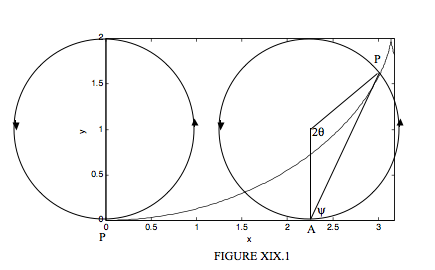19.1: Introduction to Cycloids
( \newcommand{\kernel}{\mathrm{null}\,}\)
Let us set up a coordinate system Oxy, and a horizontal straight line y = 2a. We imagine a circle of diameter 2a between the x-axis and the line y = 2a, and initially the lowest point on the circle, P, coincides with the origin of coordinates O. We now allow the circle to roll counterclockwise without slipping on the line y = 2a, so that the centre of the circle moves to the right. As the circle rolls on the line, the point P describes a curve, which is known as a cycloid.

When the circle has rolled through an angle 2\theta , the centre of the circle has moved to the right by a horizontal distance 2a \theta , while the horizontal distance of the point P from the centre of the circle is a \sin 2 \theta and the vertical distance of the point P below the centre of the circle is a \cos 2 \theta . Thus the coordinates of the point P are
x = a(2 \theta + \sin 2 \theta) \label{19.1.1} \tag{19.1.1}
and
y = a (1 - \cos 2 \theta ). \label{19.1.2}\tag{19.1.2}
Equations \ref{19.1.1} and \ref{19.1.2} are the parametric equations of the cycloid. Using a simple trigonometric identity, Equation \ref{19.1.2} can also be written
y = 2a \sin^2 \theta . \label{19.1.3}\tag{19.1.3}
When the x-coordinate of P is 2.500a, what (to four significant figures) is its y-coordinate?
Solution
We have to find 2 \theta by solution of 2 \theta +\sin 2 \theta . By Newton-Raphson iteration or otherwise, we find 2 \theta = 0.931 599 201 radians, and hence y = 0.9316a.


